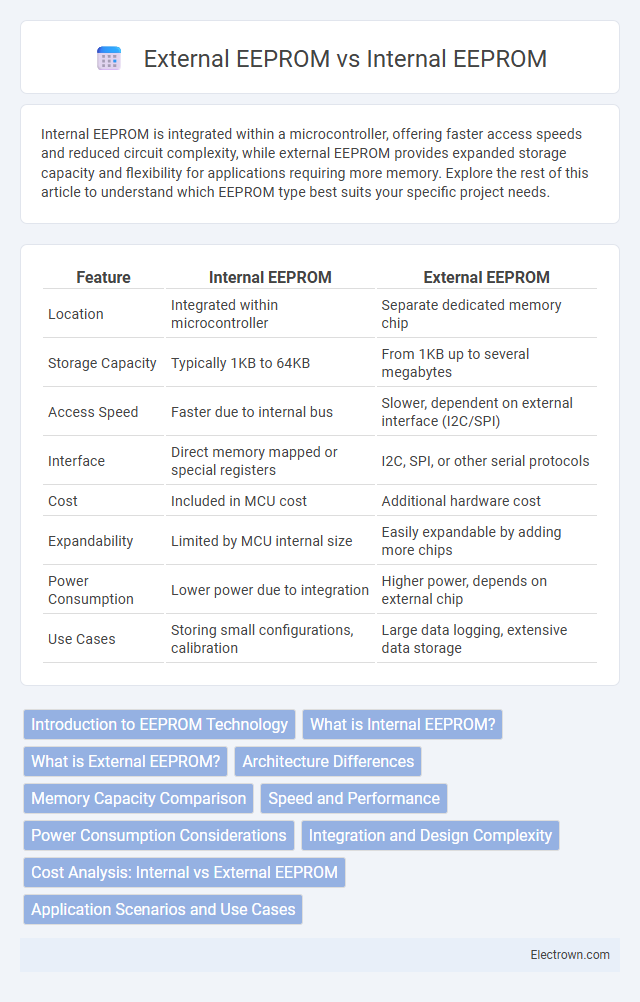Internal EEPROM is integrated within a microcontroller, offering faster access speeds and reduced circuit complexity, while external EEPROM provides expanded storage capacity and flexibility for applications requiring more memory. Explore the rest of this article to understand which EEPROM type best suits your specific project needs.
Table of Comparison
| Feature | Internal EEPROM | External EEPROM |
|---|---|---|
| Location | Integrated within microcontroller | Separate dedicated memory chip |
| Storage Capacity | Typically 1KB to 64KB | From 1KB up to several megabytes |
| Access Speed | Faster due to internal bus | Slower, dependent on external interface (I2C/SPI) |
| Interface | Direct memory mapped or special registers | I2C, SPI, or other serial protocols |
| Cost | Included in MCU cost | Additional hardware cost |
| Expandability | Limited by MCU internal size | Easily expandable by adding more chips |
| Power Consumption | Lower power due to integration | Higher power, depends on external chip |
| Use Cases | Storing small configurations, calibration | Large data logging, extensive data storage |
Introduction to EEPROM Technology
EEPROM (Electrically Erasable Programmable Read-Only Memory) technology allows data to be electrically erased and reprogrammed, enabling non-volatile storage in electronic devices. Internal EEPROM is integrated within a microcontroller, providing fast access and simplified circuit design, while external EEPROM offers greater storage capacity and flexibility for applications requiring large data retention. Your choice between internal and external EEPROM depends on memory size requirements, speed, and system architecture constraints.
What is Internal EEPROM?
Internal EEPROM is a non-volatile memory integrated within a microcontroller or semiconductor device, allowing data storage without power. It provides fast access and reliability for storing small amounts of data such as configuration settings or calibration parameters directly on the chip. You benefit from simplified circuit design and reduced component count by using internal EEPROM compared to external EEPROM modules.
What is External EEPROM?
External EEPROM refers to a separate memory chip connected to a microcontroller or processor via communication protocols like I2C or SPI, providing non-volatile storage outside the main system board. It allows for expanded storage capacity beyond the limits of internal EEPROM integrated within the microcontroller, enabling flexible data retention and more extensive memory addressing. External EEPROM chips are widely used in applications requiring larger memory space for configuration data, logs, or firmware storage while maintaining easy accessibility and data integrity.
Architecture Differences
Internal EEPROM is integrated directly within the microcontroller chip, offering faster access times and reduced latency due to its close proximity to the CPU core. External EEPROM, in contrast, exists as a separate memory module connected through interfaces like I2C or SPI, which introduces communication overhead but allows for expanded storage capacity beyond the microcontroller's internal limits. Your choice depends on the required memory size, access speed, and system complexity dictated by the distinct architectural designs of internal versus external EEPROM.
Memory Capacity Comparison
Internal EEPROM typically offers limited memory capacity, ranging from a few bytes to several kilobytes, which is integrated directly on the microcontroller chip. External EEPROM devices provide significantly larger storage options, often from 1KB up to several megabytes, enabling extensive data logging and storage needs. Choosing between internal and external EEPROM depends on the application's memory requirements and system design constraints.
Speed and Performance
Internal EEPROM typically offers faster access speeds due to its integration within the microcontroller, enabling lower latency and quicker data retrieval. External EEPROM generally exhibits slower performance because it relies on serial communication protocols such as I2C or SPI, which introduce additional communication overhead and latency. Selecting internal EEPROM is preferable for applications requiring rapid data access and frequent read/write cycles, while external EEPROM suits larger storage needs with less critical speed requirements.
Power Consumption Considerations
Internal EEPROM typically consumes less power than external EEPROM due to its integration within the microcontroller, reducing the need for additional communication interfaces that draw extra current. External EEPROM modules often require higher operational voltage and active communication lines such as I2C or SPI, increasing overall power consumption during read and write cycles. Choosing internal EEPROM is advantageous for battery-powered or energy-sensitive applications where minimizing power usage is critical.
Integration and Design Complexity
Internal EEPROM offers seamless integration within microcontrollers, simplifying your design by reducing the need for additional components and PCB space. External EEPROM requires extra wiring and interface circuitry, increasing design complexity and potential points of failure. Choosing internal EEPROM streamlines your system architecture, while external EEPROM provides flexibility for expanded storage needs.
Cost Analysis: Internal vs External EEPROM
Internal EEPROM offers a lower overall cost due to its integration within the microcontroller, eliminating the need for additional components and reducing PCB complexity. External EEPROM incurs higher expenses not just from the chip cost but also from added board space, soldering, and communication interface requirements like I2C or SPI. You can optimize your budget by choosing internal EEPROM for moderate storage needs and external EEPROM when larger capacity or flexibility is required, despite the increased cost.
Application Scenarios and Use Cases
Internal EEPROM is ideal for applications requiring compact design and fast access times, such as storing calibration data or device configuration in embedded systems. External EEPROM is preferred when larger storage capacity or easy expandability is needed, commonly found in data logging, firmware updates, or applications requiring data retention beyond the microcontroller's built-in memory. Your choice depends on balancing integration, memory size, and access speed based on specific use case requirements.
Internal EEPROM vs external EEPROM Infographic

 electrown.com
electrown.com